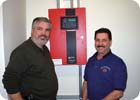Life Safety Time in Boston

Fire alarms and smoke detectors are as important as sprinklers, according to Michael Gaffney, life safety and compliance officer at Widener University in Chester, Pa. Joe Cliffe is the service manager and project coordinator for Delco Systems, the installer that Widener used for all its systems.
The National Fire Protection Association (NFPA) returns to its roots June 3-7 when it holds its World Safety Conference & Exposition at the Boston Convention & Exhibition Center. More information and registration are available at nfpa.org, which was founded in the Boston area.
Life safety and security executives make the NFPA event an essential stop thanks in part to the fire code reach of the association. More recently, NFPA has issued premises security guidelines, an innovative but controversial reach into the physical security arena.
COLLEGE APPLICATION
In other life safety news:Michael Gaffney is not a professor. Yet as the life safety and compliance officer at Widener University in Chester, Pa. — which puts him in charge of fire alarms, sprinklers, burglar alarms and all OSHA compliance and environmental issues — he teaches many of the visitors a very valuable lesson.
“When parents and their kids come to visit Widener, we have them attend an orientation in which we review the school’s various safety features,” said Gaffney, who has been at the school for 13 years. “Inevitably, someone always asks whether we have sprinkler systems in the dormitories.
“While most of our dorm rooms have sprinklers, I stress that any residential fire is far more likely to be of a smoky, smoldering nature rather than a flash. By the time the sprinkler system activates in a fire, the dorm residents should already be outside looking at the building. That’s why, as important as sprinklers are, it’s the fire alarms and smoke detectors that parents should really be concerned about. I tell them, ‘A sprinkler system will save property; smoke detectors and fire alarms will save your child’s life.’”
With such a premium placed on the fire-detection equipment, Gaffney installed systems from Silent Knight. Armed with a desire to upgrade the school’s fire equipment — and convinced that procuring it all from one manufacturer would translate to more efficient performance — Gaffney enlisted the expertise of the fire commissioner serving the City of Chester at that time.
“We did have one minor problem awhile ago,” recalled Gaffney. “One young lady got into bed — she was on the top bunk — and knocked some clothes off her bed onto a toaster, which pushed the plunger down and created a small fire in the room. However, the system responded and alerted us immediately. We contained the fire and it was basically a non-event...The fact that we had hard-wired a smoke detector protecting each and every bed on campus was critical,” he said. “We just felt it was best for the overall safety of the students.”
MONITORED EXTINGUISHERS
The Austin-Bergstrom International Airport in Austin, Texas, successfully completed the first year of its pilot program with en-Gauge electronically monitored fire extinguishers. Austin-Bergstrom, the first airport in the United States to use en-Gauge extinguishers, plans to expand its use of the technology from the current 19 extinguishers to the majority of its campus — some 650 extinguishers — over the next two years.David Slack, facilities coordinator at Austin-Bergstrom International Airport, noted that during their first year in operation, the electronically monitored extinguishers worked exactly as they were specified. “In one instance the alarm helped us address a car fire faster because the removal alarm went off.”
Electronic monitoring of fire extinguishers is recognized by the two national code bodies in the United States: the National Fire Protection Association and the International Codes Council.
Looking for a reprint of this article?
From high-res PDFs to custom plaques, order your copy today!




